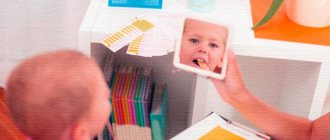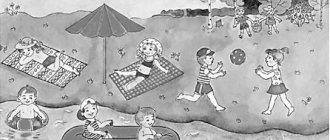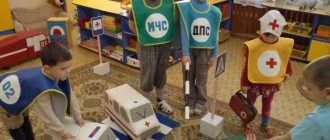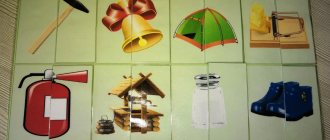Automation of sounds Ch, Shch in game exercises, Album of a preschooler, Komarova L.A., 2009
Automation of the sounds Ch, Shch in game exercises, Album of a preschooler, Komarova L.A., 2009. The manual proposes a system of exercises for automating the sounds Ch, Shch in preschoolers aged 4-7 years, which turns monotonous and monotonous work on consolidating the pronunciation of sounds into interesting game. Along with their automation, the child’s reading skills improve, fine motor skills and creative imagination develop. Automation of the sounds Ch, Shch is carried out according to the traditional scheme in speech therapy. The effectiveness of correctional work is ensured by the use of a number of auxiliary techniques (working with three-dimensional and flat toys, counting sticks, creating game situations in class). The manual is intended for individual work with a child and is addressed to speech therapists, teachers of speech therapy groups and parents of children with speech disorders. ARTICULATIVE GYMNASTICS. All exercises are performed in front of a mirror. Exercises 1. 2. 4. involve holding a static pose for a count of up to 5 (up to 10): exercises 3.5.6 are performed 10-15 times. 1. SPATULA Open your mouth. Place a wide, relaxed tongue on your lower lip. Place the “spatula” in your mouth, trying not to strain your tongue. 2. CUP Open your mouth. Raise a wide, relaxed tongue to the upper lip. Bend the middle part of the tongue, bending the side edges up. 3. HORSE Suck your tongue to the roof of your mouth, stretching the hyoid ligament. Click your tongue slowly and forcefully. The lower jaw must be motionless! 4. FUNGUS Smile (teeth visible), open your mouth slightly. Suck your wide tongue with its entire plane to the roof of your mouth and open your mouth.
Download the e-book for free in a convenient format, watch and read: - fileskachat.com, fast and free download.
Below you can buy this book at the best price with a discount with delivery throughout Russia. Buy this book
How to open a file
Copyright holders
- djvu - Yandex.Disk.
Publication date: 05/31/2019 18:38 UTC
Russian language textbook :: Russian language :: Komarova
See also textbooks, books and educational materials:
- Speech practice, 1st grade, Komarova S.V., 2017
- Speech practice, 3rd grade, Komarova S.V., 2018
- Speech practice, 2nd grade, Komarova S.V., 2018
- Automation of sounds L in game exercises, Album of a preschooler, Komarova L.A., 2008
The following textbooks and books:
- Test book, thematic control of students’ knowledge, Russian language, grade 4, practical guide for elementary school, Golub V.T., 2017
- Copy 3, For children 6-7 years old, Zhukova N.S., 2011
- Propis 2, For children 6-7 years old, Zhukova N.S., 2011
- Copy 1, For children 6-7 years old, Zhukova N.S., 2011
Previous articles:
- Russian language without errors, Quick methodology for improving literacy, Shestov M., Proskura O., 2018
- Culture of Russian business speech and business rhetoric, Rodina I.V., Promakh L.V., 2018
- Russian language, Syntax, Punctuation, Textbook and workshop for SPO, Lobacheva N.A., 2019
- Russian language in business documentation, Textbook and workshop for SPO, Ivanova A.Yu., 2019
<< Previous articleNext article >>
Books for speech therapists
Articles:
1. Aleksandrova, L. Lullabies in the system of speech therapy assistance: young children in conditions of maternal deprivation of varying degrees of severity / L.
Alexandrova // Preschool education. - 2010. - No. 10. - P. 89-95.
2. Borovtsova, L. Ways to improve the qualifications and professional skills of a speech therapist at a preschool educational institution / L. Borovtsova // Preschool education. - 2008. - No. 2. - P. 93-99.
3. Vavilkina, G. M. Relationship in the work of a speech therapist and primary school teacher / G. M. Vavilkina // Primary school. - 2007. - No. 1. - P. 43-45.
4. Vershinina, L. N. Joint work of a psychologist and speech therapist in elementary school / L. N. Vershinina, E. A. Ipkaeva // Elementary school. - 2007. - No. 11. - P. 68-74.
5. Volkova, E. N. The use of speech therapy rhythms in relieving mental stress in the process of teaching junior schoolchildren / E. N. Volkova //
Elementary School. – 2005. – No. 11. – P. 44-48.
6. Gromova, O. E. Arbitrary articulation and acquisition of the first words in the initial children’s vocabulary / O. E. Gromova // Defectology. - 2007. - No. 5. - P. 57-66.
7. Kiseleva, V. Helping a child of the third year of life with delayed speech development / V. Kiseleva, O. Gromova // Preschool education. - 2007. - No. 11. - P. 103-112.
8. Kiseleva, V. Does your child not speak? / V. Kiseleva // Preschool education. - 2007. - No. 6. - P. 103-112.
9. Kiseleva, N. Didactic manual “Logoclub”: games and activities / N. Kiseleva, N. Nikiforova // Preschool education. - 2007. - No. 7. - P. 105-106.
10. Kitik, E. E. Information technologies and training of speech therapists: educational computer program “Dislalia” / E. E. Kitik // Defectology. - 2008. - No. 1. - P. 79-84.
11. Kitik, E. E. Information technologies and training of speech therapists: educational computer program “Dyslalia: sigmatisms” / E. E. Kitik // Defectology. - 2008. - No. 3. - P. 74-84.
12. Kuznetsova, L. Didactic games for familiarizing preschoolers with spatial prepositions / L. Kuznetsova, A. Droyskaya // Preschool education. - 2007. - No. 10. - P. 106-107.
13. Lekhanova, O. How to understand yourself and others?: working with older preschoolers with general speech underdevelopment / O. Lekhanova // Preschool education. - 2007. - No. 9. - P. 100-105.
14. Makauskienė, V. Group program for speech correction for stuttering schoolchildren / V. Makauskienė, J. Orzekauskienė // Defectology. - 2005. - No. 2. - P. 70-74.
15. Ovchinnikov, A. Work of a speech therapist with bilingual children / A. Ovchinnikov // Kindergarten from A to Z. - 2010. - No. 5. - P. 55-62.
16. Pavlyuk, E. Let’s explore the world together: correctional and speech therapy work with children of senior preschool age with ODD in the conditions of a speech center at a preschool educational institution / E. Pavlyuk //
Preschool education. - 2010. - No. 3. - P. 80-85.
17. Perchatkina, E. Cooperation between speech therapist and parents / E. Perchatkina // Preschool education. - 2008. - No. 10. - P. 102-108.
18. Podobed, S. Helping children with severe speech impairments / S. Podobed // Preschool education. - 2005. - No. 1. - P. 71-73.
19. Pozhilenko, E. Introducing children to the environment and developing speech: from the experience of joint work of a speech therapist and teacher / E. Pozhilenko, E. Ignatieva // Preschool education. - 2005. - No. 1. - P. 32-40.
20. Romusik, M. Correction of general speech underdevelopment: junior preschool age / M. Romusik // Preschool education. - 2008. - No. 3. - P. 76-83.
21. Semushina, Yu. A fairy tale teaches us to speak: speech therapy fairy tales and leisure activities / Yu. Semushina // Preschool education. - 2009. - No. 12. - P. 54-65.
22. Stepanova, O. About the speech center at a preschool educational institution / Stepanova O. // Preschool education. - 2006. - No. 11. - P. 26-33.
23. Tikhonova, E. We write as we hear: [speech therapy problems] / Elena Tikhonova, recorded by Elena Kutsenko // First of September. - 2005. - December 6 (No. 82).
24. Sheremetyeva, E. V. Diagnosis and main directions of correction of motor prerequisites for articulation in young children with deviations in speech acquisition / E. V. Sheremetyeva // Defectology. - 2008. - No. 4. - P. 69-75.
25. Shokhor-Trotskaya, M.K. How your child speaks depends on you / M.K. Shokhor-Trotskaya // Science and Life. - 2006. - No. 8. - P. 39-43.
If you don’t know where to start, because there are a lot of materials and manuals, and what of this will really be useful in practice is unknown, then we invite you to familiarize yourself with our speech therapist’s starter kit, which was compiled by specialists with many years of experience.
It includes all the most necessary materials and lectures that are needed at the initial level, when practical skills are still lacking or it is necessary to restore/update knowledge. Read more.
The methodological manual is devoted to techniques for automating the sound Ш and introducing it into speech in cases of erased dysarthria. Automation of sounds and their introduction into speech is the most difficult aspect of a speech therapist’s work with a child with erased dysarthria. All speech therapists have encountered these difficulties.
The manual will reveal the theoretical and practical essence of tactile-kinesthetic stimulation, bioenergoplasty, kinesiotherapy, as ways to overcome long-term automation in erased dysarthria. Neurostimulation techniques for automating sounds will be discussed, and the secrets of innovative techniques for the process of automating sounds for dysarthria will be revealed. The manual covers practical techniques that have been tested by experience and time. The manual contains rich lexical material illustrating all stages of automation of the sound Ш.
The stage of sound automation is the consolidation of conditioned reflex speech-motor connections on lexical material of varying complexity until the skill is fully strengthened.
Motor programming is included in the general program of speech action and is realized in the speech act. The quality of this implementation depends on skill. A skill is an automated component of conscious activity that arose as a result of exercise, a fixed method of action.
Skill as a way of strengthened implementation of speech action is closely related to the articulatory base. A skill is determined by experience, in this case speech experience, which is not only supported by conditioned reflex connections, but also leads to the emergence of a speech mechanism, or speech ability. This mechanism is formed in each person on the basis of the innate psychological characteristics of the body and under the influence of verbal communication. For a lasting skill, long-term exercises are needed, which are gradually formed from knowledge and skills to a fixed automatism - a skill. Knowledge and skills are formed through exercises and create the opportunity to perform actions not only in familiar conditions, but also in changed ones.
With erased dysarthria, defective articulatory skills are noted, formed as a pathological stereotype. The speech therapist is faced with the task of weakening and extinguishing defective articulation skills. Therefore, the process of developing new skills and abilities during correctional training is fundamental in the work of a speech therapist.
Children with erased dysarthria have incorrect stereotypes of pronunciation of sounds in various speech materials. Therefore, automation of sound requires the active use of the process of internal inhibition, the ability to differentiate correct and incorrect articulation patterns. It is carried out according to the principle “from simple to complex.”
First of all, the inclusion of sound in syllables is carried out. A syllable is the simplest speech unit. Syllables do not matter, and therefore the child does not have stereotypes in the pronunciation of syllables, and this makes them easier to automate.
When incorporating automated sound into words, it is necessary to provide for a number of requirements for lexical material. Firstly, it should contain the maximum number of sounds that can be assigned. Secondly, it should not contain sounds that the child pronounces incorrectly. Thirdly, it is necessary to take into account the semantic accessibility of lexical material. When including new words, it is necessary to clarify the semantics (meaning) of the words, which will expand the child’s passive vocabulary.
Before revealing the author's innovative automation techniques, we want to give historical aspects of sound correction and automation.
Historical aspects of sound correction and automation
In classical speech therapy, when correcting sound pronunciation, the recommendations of M.E. are used. Khvattseva. During initial automation, the sound should be at the beginning of the word under stress. In such positions, sounds are more easily automated. Then children learn to pronounce sounds in any combination.
Continuing the traditions of classical speech therapy, M.F. Fomicheva clarified that sounds in speech are not used in isolation. You should start automating sound with straight syllables, because the child has the opportunity to create the desired consonant articule and move to the vowel. First, a straight syllable with a vowel [a] is given, since when pronouncing it the lips are in a neutral position, the mouth is wide open, the tongue is in a lower position, which does not interfere with the articulation of the automated sound. Then they automate the sound with the vowel [s]. This is also a non-labialized sound and has less influence on the previous consonant. Next are syllables with [o] and [y]. Straight syllables in combination of a consonant with a vowel [e] are usually not used, because they are not typical for the Russian language and are found mainly in borrowed words (“mayor”, “sir”, etc.). The sound is then fixed in reverse syllables. Next, it is recommended to fix the sound in an intervocalic position (between two vowels) and, finally, in syllables with a consonant cluster.
In accordance with this sequence, to automate the sound in words, the corresponding lexical material is selected (words with the syllables SG, GS, GSG, SSG, GSS, etc.). The place of sound in a word also matters. The following sequence of automation is recommended: first, the sound is fixed at the beginning of the word (before the vowel), then at the end (if the sound is dull), then in the middle, because this position turns out to be the most difficult. First, the sound is automated in words with a simple syllabic structure, then in words of a more complex syllabic structure containing a combination of this sound with correctly pronounced sounds. Consolidation of sounds in sentences is carried out on the basis of worked words in the same sequence.
Certain requirements are imposed on lexical material in relation to semantics. Speech material (words, phrases) should be accessible to the child and, if possible, borrowed from everyday life, and then a vocabulary that is more complex in semantics is used.
A certain sequence for automation was proposed by G.V. Gurovets and S.I. Mayevskaya. Lexical material for consolidating sounds should be selected taking into account the gradual increase in the syllabic complexity of the word. It is proposed to first introduce sound into two-syllable and then into three-syllable words with straight syllables. Then they move on to words with a reverse syllable. And then they move on to one-syllable and two-syllable words with a combination of consonants at the beginning of the word. Gradually, words with fixed sounds are introduced into the phrase in other contexts.
When selecting lexical material for automating sounds, especially words with a combination of consonants, one should take into account the data of A.K. Markova about the sequence of appearance of sound combinations in ontogenesis. A.K. Markova determined the following sequence.
In the middle of the word: [nt, xt, kb, mp, dl, kt, gd, pl, tk, kt, st, tl, lk, pt].
At the beginning of the word: [gr, cr, sun, dv, dl, pl, vm, dn, gn].
The issue of automation of sounds was also developed by E.F. Sobotovich. It was noted that insufficient attention is paid to techniques for reinforcing correct sound pronunciation in spontaneous speech. Speech therapy work comes down to developing the correct pronunciation of defective sounds in various types of syllables and sound combinations, then in words, sentences and various types of expanded speech. In parallel with this, work is being done to differentiate mixed sounds. This scheme, without any significant changes, is used to correct any phonetic disorders, i.e. when the phonetic defect is the only defect in the child’s entire speech and when the phonetic disorder is part of the structure of a defect in a more complex speech pathology.
Experimental studies by E.F. Sobotovich showed that the process of forming and consolidating the correct pronunciation of sounds in words proceeds differently in children with the same types of sound pronunciation disorders. A correlation was discovered between the process of restructuring sound pronunciation skills, automation and their level of general speech development.
In children with a high and normal level of speech formation, automation processes in any variant of the phonetic context proceed without difficulty. In children with a low level of speech formation, due to insufficiently formed phonemic hearing, automation is difficult. It is emphasized that the process of perception and pronunciation of individual sounds and simple syllable combinations is largely more elementary compared to the process of forming and consolidating the correct pronunciation of words. Consequently, the perception of sounds included in a word and their correct placement within a word depends on the level of development of phonemic hearing. This determines the leading role of phonemic hearing in the process of sound automation.
A necessary condition for successful sound automation, according to T.B. Filicheva, is a gradual and systematic increase in the tempo of speech exercises. The requirement to adhere to strict consistency when working on sound automation involves a gradual and systematic complication of speech material, a transition from simple types of speech activity to more complex ones. From elementary repetition of words to naming objects, actions, reproducing poems from memory and then to retelling, and finally to free verbal communication.
Automation, according to T.B. Filicheva, must be carried out in strict sequence:
1) automation of sound in syllables (direct, reverse, with a combination of consonants);
2) automation of sound in words (at the beginning of the word, middle, end);
3) automation of sound in a sentence;
4) automation of sound in pure sayings and poetry;
5) automation of sounds in short, then long stories;
6) automation of sounds in colloquial speech.
Multifunctional correctional and developmental aids for automation and differentiation of speech sounds
Regina Yarullina
Multifunctional correctional and developmental aids for automation and differentiation of speech sounds
Goal: to increase the effectiveness of correctional and developmental work on the formation of correct sound pronunciation in preschoolers with various speech , to involve parents in the educational process and to make homework on automating sounds easier and more accessible.
Tasks:
To increase interest and motivation in preschoolers for speech therapy classes
Develop the correct articulatory patterns of sounds using game articulatory gymnastics
Consistently automate set sounds in syllables , words, phrases, sentences
Practice determining the position of automated sounds in a word
Develop the ability to differentiate automated sounds in your speech and use them correctly
Develop fine motor skills
Develop phonemic hearing and perception
Develop coherent speech
Form the lexical and grammatical structure of speech
Develop attention, memory, thinking, imagination and perception
Strengthen the skills of sound analysis and synthesis
Develop control over your own speech
Form elementary mathematical concepts in preschoolers
Introduce parents to the sequential stages and various techniques for automating sounds
Provide practical assistance to parents in completing homework on automation and differentiation of speech sounds .
Description:
Writer L. S. Sukhorukov wrote that “our speech is the most important part not only of our behavior, but also of our personality, our soul, and mind.”
Timely mastery of all aspects of speech in preschool age is of great importance for the formation of a child’s full-fledged personality and his successful education at school.
A child with well-developed speech easily enters into dialogue, he can freely express his thoughts and desires, ask questions, agree on joint activities, and conversely, unclear speech makes relationships with others very difficult and often leaves a heavy imprint on his character.
Based on the above, my main goal, as a teacher-speech therapist, is to help children master correct, clear, expressive speech with an age-appropriate vocabulary and level of development of coherent speech , through the use of various methods and techniques of speech therapy aimed at correcting speech defects .
Most often, speech defects are observed in sound pronunciation , which is quite difficult to form correctly, since the child needs to learn to control his organs of articulation, to exercise control over his own speech and the speech of others.
Correction of impaired pronunciation is carried out step by step and sequentially. The stage of automation of sounds is designated in the methodology of speech therapy for correcting sound pronunciation as the stage of formation of primary pronunciation skills (according to L. S. Volkova)
.
Its goal is to teach the child to correctly pronounce an already delivered sound .
As you know, pronunciation is first fixed in isolation, then in syllables, words, phrases. In parallel, the work begun in the preparatory period continues to develop sound analysis , the ability to determine the position of a sound in a word , and select words with a given sound . To automate sound, techniques of reflected repetition and independent naming of language units from pictures, diagrams, and symbols are used. The work proceeds sequentially and gradually, from simple to complex.
In case of severe speech disorders, the stage of automation is delayed ; for a long time, the child is unable to correctly pronounce the given sound in syllables and words , not to mention phrases. Repeated repetition of the same speech material tires the child. The matter is further complicated by the fact that for some sounds the speech material is very limited (for example, [g], [d], [y], [sch], etc.)
.
If the child is “stuck”
on
automating isolated sound , then there is no need to talk about the variety of techniques.
Therefore, so that the child does not lose interest in classes and the desire to visit the speech therapist’s office, I look for new approaches to the same exercises, try to diversify gaming methods and techniques of my work, give children new creative tasks to consolidate correct pronunciation. The constant search for new gaming techniques led me to create multifunctional Velcro aids for automating and differentiating speech sounds . These manuals are intended for individual lessons with preschool children. Each manual contains a lot of games with varied and colorful speech material, with changing plots and exercises based on articulatory gymnastics techniques, and stages of automation and differentiation of speech sounds .
Results achieved:
The use of these benefits in work made it possible to create the most favorable conditions for the development speech and increase interest in speech therapy classes.
Children began to consolidate the sounds , and creating their own stories in the game allowed them to easily introduce automated sounds into independent speech. Children have improved their ability to correctly construct lexical and grammatical sentences, train auditory and visual memory, develop thinking, memory, attention, and form elementary mathematical concepts.
Parents, with the help of a manual at home, practiced the acquired skills in their children’s classes, which contributed to the improvement of sound pronunciation in preschoolers .
Social significance:
Correct speech is the most important mental function of a person. Speech communication promotes social contact between people, thanks to which higher forms of activity develop. The richer and more correct a child’s speech, the easier he expresses his thoughts, the better he understands reality, the more fully he builds relationships with children and adults, which is one of the keys to a person’s success in the modern world.
Thus, the availability of manuals to a wider audience made it possible to include parents in joint work, create a unified space for the child’s speech development and significantly increase the effectiveness of correctional speech therapy work on the formation of correct sound pronunciation in preschool children with various speech .
Books to help
Speech therapy massage and articulation gymnastics. Practical guide, ed. Krause E. N.
Description: This methodological guide is a reminder for beginning speech therapists and a training manual for parents who want to help their children overcome various types of speech defects.
Stuttering plans
Stuttering plans
Speech therapist lessons. Correction of speech disorders. Zhukova N.S.
The proposed manual “Lessons of a speech therapist” is intended for speech therapists, educators, Russian language teachers and their students.
In its methodological part, it can be used by teachers of speech technology and people of speech professions who want to improve their diction.
Speech therapy massage for dysarthria. Arkhipova E.F.
Massage is a method of treatment and prevention, which is a set of techniques of mechanical influence on various areas of the surface of the human body. The mechanical effect changes the condition of the muscles, creates positive kinesthesia necessary for normalizing the pronunciation aspect of speech.
Automation of the sound Рь in game exercises. Album of preschooler L. A. Komarov
The manual offers a system of exercises for automating sounds for preschoolers aged 4-7 years, which turns the monotonous and monotonous work of strengthening the pronunciation of sounds into an interesting game. Along with its automation, the child’s reading skills improve, fine motor skills and creative imagination develop.
The manual is intended for individual work with a child and is addressed to speech therapists, teachers of speech therapy groups and parents of children with speech disorders.
Automation of the sound R in game exercises. Preschooler's albumL. A. Komarova
The manual offers a system of exercises for automating the sound “R” for preschoolers aged 4-7 years, which turns the monotonous and monotonous work of consolidating the pronunciation of the sound into an interesting game. Along with its automation, the child’s reading skills improve, fine motor skills and creative imagination develop.
Speech therapist lessons. Correction of speech disorders. Nadezhda Zhukova
Nadezhda Sergeevna Zhukova is a well-known speech therapist with thirty years of experience, candidate of pedagogical sciences. She is the author of original research on speech development in preschool children. The best traditions of such famous Soviet teachers and speech therapists-practitioners as E.F. Rau, A.G. Ippolitova were continued in the new book by N.S. Zhukova: “Lessons of a Speech Therapist.”
The textbook “Lessons of a Speech Therapist” will solve speech problems at any age scientifically, thoroughly, radically and forever.



![Visual and didactic manual on sound automation [C] “Interesting cards”](https://pleshakof.ru/wp-content/uploads/naglyadno-didakticheskoe-posobie-po-avtomatizacii-zvuka-s-interesnye-kartochki-330x140.jpg)


